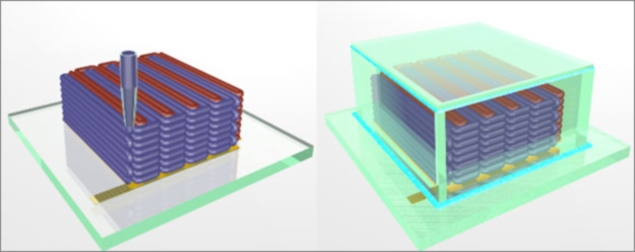- Home
- Others
- Others News
- 3D printed lithium ion micro batteries developed
3D-printed lithium-ion micro-batteries developed
By Indo-Asian News Service | Updated: 19 June 2013 15:26 IST

Click Here to Add Gadgets360 As A Trusted Source

Advertisement
US researchers announced they have successfully used the three-dimensional (3D) printing technique to print lithium-ion micro-batteries the size of a grain of sand.
The printed micro-batteries could supply electricity to tiny devices in fields from medicine to communications, including many that have lingered on lab benches for lack of a battery small enough to power them, according to a research team from the Wyss Institute at Harvard University and the University of Illinois at Urbana-Champaign.
"Not only did we demonstrate for the first time that we can 3D- print a battery, we demonstrated it in the most rigorous way," senior author Jennifer Lewis of the Harvard University said in a statement.
To make the micro-batteries, the team had to print precisely interlaced stacks of tiny battery electrodes, each less than the width of a human hair, reported Xinhua.
The researchers first created and tested several specialized inks. Unlike the ink in an office inkjet printer, which comes out as droplets of liquid that wet the page, the inks developed for extrusion-based 3D printing must fulfill two difficult requirements: they must exit fine nozzles like toothpaste from a tube and must immediately harden into their final form.
The inks also had to function as electrochemically active materials to create working anodes and cathodes, and they had to harden into layers that are as narrow as those produced by thin-film manufacturing methods.
In the end, the researchers created an ink for the anode with nano particles of one lithium metal oxide compound, and an ink for the cathode from nano particles of another.
The printer deposited the two inks onto the teeth of two gold combs, creating a tightly interlaced stack of anodes and cathodes. Then the researchers packaged the electrodes into a tiny container and filled it with an electrolyte solution to complete the battery.
The researchers said despite its tiny size, the battery's electrochemical performance is "comparable to commercial batteries" in terms of charge and discharge rate, cycle life and energy densities.
The findings were published online in the journal Advanced Materials.
The printed micro-batteries could supply electricity to tiny devices in fields from medicine to communications, including many that have lingered on lab benches for lack of a battery small enough to power them, according to a research team from the Wyss Institute at Harvard University and the University of Illinois at Urbana-Champaign.
"Not only did we demonstrate for the first time that we can 3D- print a battery, we demonstrated it in the most rigorous way," senior author Jennifer Lewis of the Harvard University said in a statement.
To make the micro-batteries, the team had to print precisely interlaced stacks of tiny battery electrodes, each less than the width of a human hair, reported Xinhua.
The researchers first created and tested several specialized inks. Unlike the ink in an office inkjet printer, which comes out as droplets of liquid that wet the page, the inks developed for extrusion-based 3D printing must fulfill two difficult requirements: they must exit fine nozzles like toothpaste from a tube and must immediately harden into their final form.
The inks also had to function as electrochemically active materials to create working anodes and cathodes, and they had to harden into layers that are as narrow as those produced by thin-film manufacturing methods.
In the end, the researchers created an ink for the anode with nano particles of one lithium metal oxide compound, and an ink for the cathode from nano particles of another.
The printer deposited the two inks onto the teeth of two gold combs, creating a tightly interlaced stack of anodes and cathodes. Then the researchers packaged the electrodes into a tiny container and filled it with an electrolyte solution to complete the battery.
The researchers said despite its tiny size, the battery's electrochemical performance is "comparable to commercial batteries" in terms of charge and discharge rate, cycle life and energy densities.
The findings were published online in the journal Advanced Materials.
Comments
Get your daily dose of tech news, reviews, and insights, in under 80 characters on Gadgets 360 Turbo. Connect with fellow tech lovers on our Forum. Follow us on X, Facebook, WhatsApp, Threads and Google News for instant updates. Catch all the action on our YouTube channel.
Further reading:
3D Printing, Batteries, Harvard, Lithium ion micro batteries, Micro batteries, Science
Related Stories
Popular on Gadgets
- Samsung Galaxy Unpacked 2025
- ChatGPT
- Redmi Note 14 Pro+
- iPhone 16
- Apple Vision Pro
- Oneplus 12
- OnePlus Nord CE 3 Lite 5G
- iPhone 13
- Xiaomi 14 Pro
- Oppo Find N3
- Tecno Spark Go (2023)
- Realme V30
- Best Phones Under 25000
- Samsung Galaxy S24 Series
- Cryptocurrency
- iQoo 12
- Samsung Galaxy S24 Ultra
- Giottus
- Samsung Galaxy Z Flip 5
- Apple 'Scary Fast'
- Housefull 5
- GoPro Hero 12 Black Review
- Invincible Season 2
- JioGlass
- HD Ready TV
- Laptop Under 50000
- Smartwatch Under 10000
- Latest Mobile Phones
- Compare Phones
Latest Gadgets
- Redmi Note 15 5G
- Redmi Note 15 Pro 5G
- Redmi Note 15 Pro+ 5G
- Lava Play Max
- Poco C85 5G
- Honor Magic 8 Lite
- Jolla Phone
- Realme P4x 5G
- Asus ProArt P16
- MacBook Pro 14-inch (M5, 2025)
- OnePlus Pad Go 2
- Poco Pad M1
- Just Corseca Skywatch Pro
- Honor Watch X5
- Acerpure Nitro Z Series 100-inch QLED TV
- Samsung 43 Inch LED Ultra HD (4K) Smart TV (UA43UE81AFULXL)
- Asus ROG Ally
- Nintendo Switch Lite
- Haier 1.6 Ton 5 Star Inverter Split AC (HSU19G-MZAID5BN-INV)
- Haier 1.6 Ton 5 Star Inverter Split AC (HSU19G-MZAIM5BN-INV)
© Copyright Red Pixels Ventures Limited 2025. All rights reserved.

















